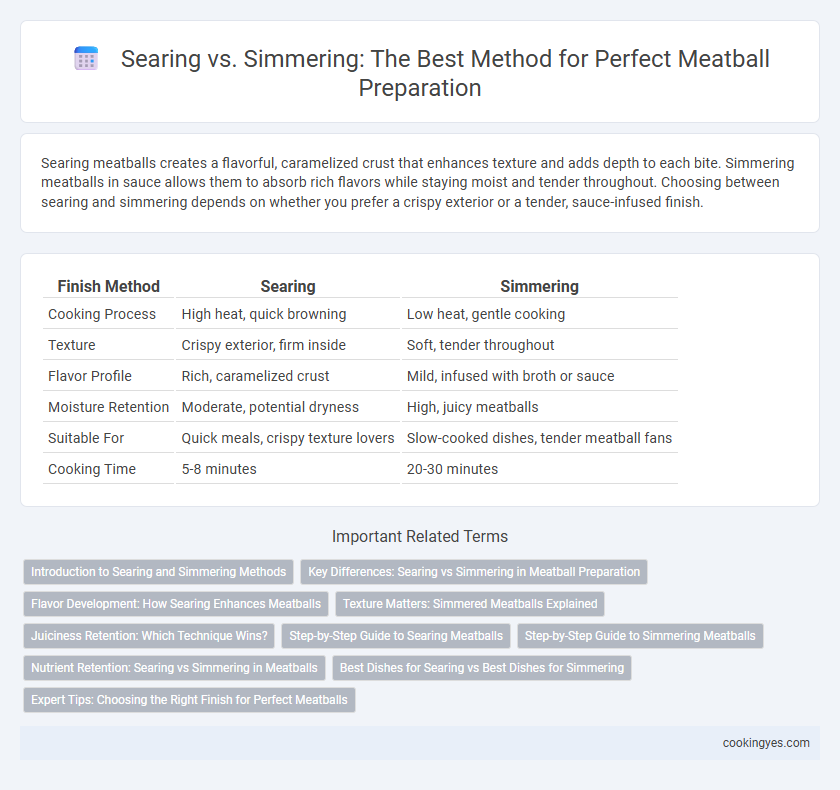Searing meatballs creates a flavorful, caramelized crust that enhances texture and adds depth to each bite. Simmering meatballs in sauce allows them to absorb rich flavors while staying moist and tender throughout. Choosing between searing and simmering depends on whether you prefer a crispy exterior or a tender, sauce-infused finish.
Table of Comparison
| Finish Method | Searing | Simmering |
|---|---|---|
| Cooking Process | High heat, quick browning | Low heat, gentle cooking |
| Texture | Crispy exterior, firm inside | Soft, tender throughout |
| Flavor Profile | Rich, caramelized crust | Mild, infused with broth or sauce |
| Moisture Retention | Moderate, potential dryness | High, juicy meatballs |
| Suitable For | Quick meals, crispy texture lovers | Slow-cooked dishes, tender meatball fans |
| Cooking Time | 5-8 minutes | 20-30 minutes |
Introduction to Searing and Simmering Methods
Searing meatballs involves cooking them at high heat to create a caramelized crust that enhances flavor and texture, locking in juices for a tender interior. Simmering, in contrast, cooks meatballs gently in a liquid such as tomato sauce, allowing flavors to meld and the meat to remain moist and tender. Choosing between searing and simmering depends on desired texture and flavor profile, with searing favoring a crispy exterior and simmering ensuring uniform cooking and infusion of sauce flavors.
Key Differences: Searing vs Simmering in Meatball Preparation
Searing meatballs creates a caramelized crust that enhances flavor through the Maillard reaction, resulting in a rich, savory exterior. Simmering meatballs in sauce ensures thorough cooking and infuses them with moisture and complementary flavors, making them tender and juicy. The key difference lies in searing providing texture and taste contrast, while simmering emphasizes moisture retention and integration with the sauce.
Flavor Development: How Searing Enhances Meatballs
Searing meatballs creates a flavorful Maillard reaction, producing a rich, caramelized crust that enhances depth and complexity. This intense browning adds savory notes and a satisfying texture absent in simmered meatballs, which cook gently in liquid, preserving moisture but lacking that robust flavor. The combined use of searing before simmering maximizes both taste and tenderness, delivering meatballs with a perfectly balanced profile.
Texture Matters: Simmered Meatballs Explained
Simmered meatballs develop a tender, juicy texture as they cook gently in sauce, allowing flavors to meld without the risk of drying out. The low, consistent heat helps retain moisture, making each bite soft and succulent compared to the crusty exterior achieved by searing. Texture matters because simmering enhances meatball tenderness, ideal for sauces and slow-cooked dishes where softness is preferred over a crispy finish.
Juiciness Retention: Which Technique Wins?
Searing meatballs creates a flavorful crust that locks in moisture, significantly enhancing juiciness compared to simmering. Simmering gently cooks meatballs in liquid, which can cause some moisture loss but ensures even cooking throughout. For maximum juiciness retention, searing followed by a brief simmer is often the optimal technique.
Step-by-Step Guide to Searing Meatballs
Searing meatballs creates a flavorful crust by cooking them over high heat in a skillet with oil for 2-3 minutes per side until browned. This technique locks in juices, enhancing tenderness and depth of flavor. After searing, transfer meatballs to a simmering sauce to finish cooking evenly and absorb rich flavors.
Step-by-Step Guide to Simmering Meatballs
Simmering meatballs involves gently cooking them in a flavorful liquid, such as tomato sauce or broth, at a low temperature to ensure even cooking and tender texture. Begin by bringing the sauce to a gentle simmer, then carefully add the raw or partially cooked meatballs, maintaining a temperature just below boiling around 185degF to 200degF (85degC to 93degC). Simmer for 20 to 30 minutes, turning occasionally to cook thoroughly and infuse the meatballs with rich, savory flavors while keeping them moist and juicy.
Nutrient Retention: Searing vs Simmering in Meatballs
Searing meatballs creates a flavorful crust by applying high heat, which helps retain certain water-soluble vitamins like B-complex but may cause some loss of heat-sensitive nutrients. Simmering meatballs in a liquid at lower temperatures preserves moisture and protects delicate vitamins such as folate and vitamin C, though prolonged simmering can lead to nutrient leaching into the broth. For optimal nutrient retention, combining searing to lock in nutrients with brief simmering to finish cooking balances flavor development and vitamin preservation in meatballs.
Best Dishes for Searing vs Best Dishes for Simmering
Searing meatballs creates a caramelized crust, ideal for dishes like spaghetti and meatballs or meatball subs where a crispy exterior enhances texture and flavor. Simmering meatballs in sauce works best for dishes such as Swedish meatballs or albondigas soup, where tender, moist meatballs absorb the sauce's richness. Choosing searing or simmering depends on whether the dish benefits from a browned surface or a juicy, sauce-infused finish.
Expert Tips: Choosing the Right Finish for Perfect Meatballs
Searing meatballs creates a caramelized crust that locks in juices, enhancing flavor and texture, ideal for crispy, browned finishes. Simmering in sauce allows the meatballs to absorb moisture and meld with the sauce, resulting in tender, flavorful bites perfect for classic Italian dishes. Experts recommend searing first for maximum depth, then simmering gently to balance crispness with succulence.
Searing vs Simmering for Meatball Finish Infographic

 cookingyes.com
cookingyes.com